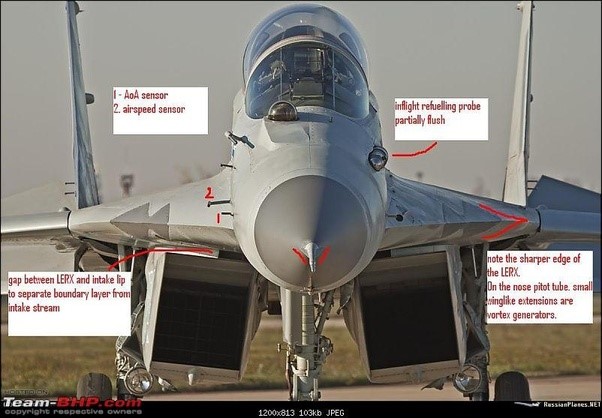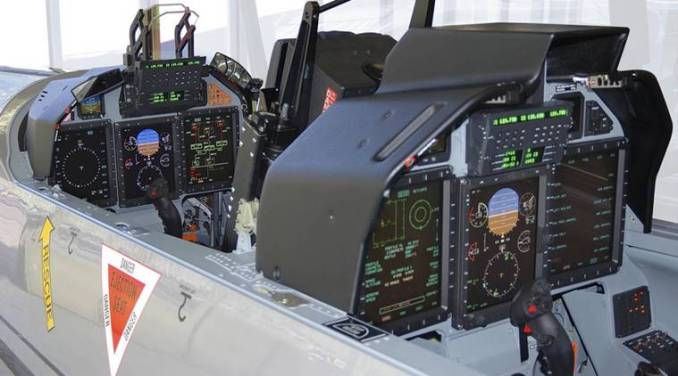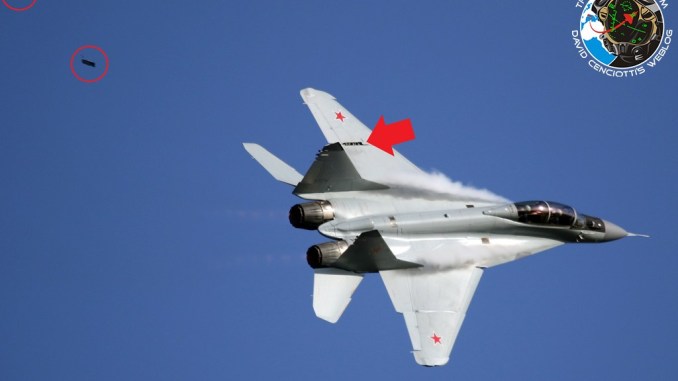
Overview
Russia’s MiG-35 Fulcrum F is an export version of MiG-29KR and was designed by Mikoyan design bureau in the early 2000s. The MiG-35 is exported without the arrester tail hook of MiG-29KR and requires no further modification. The multi-role fighter aircraft earlier served as MiG-29M2 or MiG-29KR model. The plane has been designed as 4++ generation fighter by Mikoyan. It has been classified as a medium-weight fighter plane by the design bureau.

The plane is entirely made in Russia with Rostec companies like United Engine Corporation (UEC), KRET and Technodinamika contributing to the project.
Russia’s MiG has signed an agreement with Kazakh firm Kazakhstan Engineering to help promote the MiG-35 ‘Fulcrum-F’ to the Kazakh government, alongside a number of potential workshare and offset agreements.
Key Points
- MiG-35 is a new production run of MiG-29.
- Zhuk-AME AESA radar is yet to be integrated with MiG-35 due to the overheating issues of Russian-made AESA radar. IHS Janes reported that the Zhuk-AME radar will be tested until the year 2020.
- The engines have been designed for short lifespans. The Engine has relatively short Mean Time Between Overhauls (MTBO) of a few hundred hours and short total life spans.
- Limited autonomous operations, poor navigation, poor reliability, poor display, poor situational awareness, problems with targets flying in formation
- MiG-35 is $50 million dollars capital spends for numerical boost to airforce strength not a real air dominance fighter jet.
- MiG-35 has low acquisition cost but high maintenance cost, high life cycle cost and poor after sales support
- MiG-35 will not be developed further and has no roadmaps for a mid-life upgrade.
- The export variant of MiG-35 will be fitted with significantly less capable Zhuk-M mechanically scanned Pulse Doppler radar
- The MiG-35 is a revival attempt of Mikoyan’s production line and the last opportunity to keep the Mikoyan Design Bureau in business
Airframe
The 17.32 m aircraft has a wing span of 12 m and can carry up to 7000 kg of payload. The airframe has been redesigned and enlarges to accommodate more fuel and carry more armament. The rear end of aircraft has been modified to house new engine. The MiG-35 has been installed with a quadruply-redundant fly-by-wire control system
Read More From Russia with Dud: Meet the Sukhoi Su-30 and Su-35 Fighter Jets
Powerplant
Fitted with two Klimov RD-33MK engines, the MiG-35 has 7 percent more power than its predecessor and offers higher thrust. The engines also include systems which reduce the infrared and optical visibility of the aircraft.
The MiG-35 has an increased ferry range of up to 3100 km with its three external fuel tanks, along with an in-flight refuelling option taking its range up to 5,400 km. The MiG-29, on the other hand, has a ferry range of 1,500 km with no external fuel tanks and 2,100 km with external tanks.
Read More Russian Missiles Don’t Work Says Indian Air Force
It had a retrofitted in-flight refuelling probe and increased internal fuel capacity, alleviating the shorter combat radius of older models.
Radar
The manufacturer claims that it has the newly built Phazatron Zhuk active phased array radar system which can detect 30 targets at a range of 130 km in the air and 300 km in water, and can engage with 6 targets at a time.
The 600-mm.-dia. (24-in.) Prototype radar with 680 transmit/receive (TR) modules has been tested on a MiG-35 since 2008. Fight tests verified its operating range against air and ground targets and in ground-mapping modes. The prototype has a detection range of 60-65 km. (37-40 mi.).

The radar is yet to be proven its countermeasures capability. The radar can only detect incoming fighters at least from 50 km and outgoing fighters at least from 90 km. It can also detect a tank at 20 km.
The various Russian sources reported that the Zhuk-AE or Zhuk-MA or Zhuk-ME is the Russians AESA under development and has been fitted to the MiG 35 prototype being offered to India as their new “low” capability fighter to complement their “high” capability SU 30MKI.
The Zhuk Radar is quite small, and there would have to be cooling constraints in the smaller nosecone. Given these limitations and the immaturity of the system, you could assume it would still be quite inferior to western and other Russian radars in all parameters.
The radar uses multiple four channel transceivers modules generating an output of 5watt per channel, installed on a liquid cooled base plate to dissipate the generated heat. If a specific transceiver is overheated, it will be switched off by the radar computer until it cools down.
The export variant of MiG-35 will be fitted with significantly less capable Zhuk-M mechanically scanned pulse doplar radar as seen on Egyptian Mig-29M2.
Radar Cross Section
The Mig-35 has a radar cross section of 5sqm which is reduced significantly considering previous generations MiG-29 has RCS of 25sqm. Still a 5sqm frontal RCS makes it highly visible to modern AESA radar, — a very high RCS fighter aircraft comparing fourth generation fighter aircraft of the west.
Sensor
An optional OLS-UEM electro-optical-infrared device serves as MiG-35’s passive search-and-track sensor, which might be able to detect emissions from other plans.

The cockpit ergonomics and interface is modernised, with dual multifunction LCDs and HOTAS. The OLS on the nose serves as the IRST while the OLS under the right air intake serves as the ground strike designator.
In air combat, the optronic suite allows:
Detection of non-afterburning targets at 45 km range and more;
Identification of those targets at 8 to 10 km range; and
Estimates of aerial target range at up to 15 km.
For ground targets, the suite allows:
A tank-effective detection range up to 15 km, and aircraft carrier detection at 60 to 80 km;
Identification of the tank type on the 8 to 10 km range, and of an aircraft carrier at 40 to 60 km; and
Estimates of the ground target range of up to 20 km.
The defensive system equipment consists of radar reconnaissance, electronic countermeasures, and optical systems (notably the laser emission detector on each wingtip) which can detect and evaluate the approaching danger and operate decoy dispensers to counteract the approaching threat in the radar and infrared ranges.
Italy-based Elettronica signed an agreement with Mikoyan in 2007 to support in incorporating ELT/568(V)2 self-protection jammer in the MiG-35. The jammer renders self-defence from radar-controlled anti-aircraft artillery.
Variants
The MiG-35 comes in single-seat and two-seat variant, MiG-35D.
Cockpit
The MiG-35 has a glass cockpit adapted for night vision goggles. Analog electronics are minimised, being replaced by 3 equal-size colour LCD multi-function displays (MFDs) and an additional display for the OLS (the MiG-35D rear cockpit has four LCDs).

Armament
MiG-35 can carry up to 7,000 kg of payload. The fighter plane packs 30-mm cannon and 150 rounds of ammunition on board. It can also use air-to-air and air-to-surface missiles along with guided and unguided rockets and bombs.
The aircraft’s suite of guided weapons includes Kh-31A anti-ship missiles with active radar seekers, the Kh-31P anti-radar missiles, Kh-29TE missiles and KAB-500Kr TV-guided bombs. Added, when equipped with an external optical / laser targeting pod, the fighter can use the Kh-29L air-to-surface missiles and KAB-500L laser-guided bombs. These weapons will allow the aircraft to engage aerial and land targets.
Flight Testing
According to sources cited by military today website, at least 10 prototypes of the aircraft have been developed. In 2017 January, Russia started flight tests of MiG-35 fighter aircraft. An international presentation of the plane was held in Moscow on January 27. According to Russian officials, the first combat-ready plane will be delivered to the Air Force by 2020.

Comparison with MiG-29
- The nose radome is slighter longer and reduced in diameter along with the cockpit; canopy linings are lowered to improve downward and lateral visibility.
- The LERX have sharper leading edges. This enhances vortex formation at high alpha and reduces drag, but adds manufacturing costs and volume inside the wing root compartments.
- The vertical stabilisers are increased in overall area.
- The position of the engine is adjusted further aft, moving the aircraft’s centre of gravity further rearward. This enhances pitch-authority.
- Increased space between the airframe and intake splitter plates improves the quality of intake stream, aiding fuel efficiency.

The limitations of MiG-35
According to Military Today, in spite of its modern features, the avionics and sensors of MiG-35 are inferior when compared with Western designs. Furthermore, Russia has a limited production of proposed MiG-35 aircraft, which are not much threat to Western air forces. Also, in spite of its high manoeuvrability, the plane sacrifices in range and weight to attain agility, according to US magazine National Interest.
“The current plane is essentially an upgrade of the MiG-29KR,” according to Russian industry source. “There is no thrust vectoring. Moreover, the lack of an AESA radar adds to the existing problems from a procurement standpoint.”
The Zhuk-ME radar lacks many new standard features like intra-flight data link networking but can network with GCI and SAM sites within a shorter radius.
The Egyptian Air Force variant of MiG-35 will be delivered without an AESA radar due to the unavailability of export variant Zhuk radar and overheating issues of the radar.
Mikoyan Design Bureau’s Quality Control Issues Remain Since Algeria Rejected Mig-29.
A new MiG-35D two-seat, advanced “generation 4++” fighter lost a large wing panel from its left wing after takeoff during a flight demonstration at the MAKS Aviasalon 2019 air show at Zhukovsky Air Base outside Moscow on Thursday, August 29, 2019. The aircraft, which may have been crewed by a delegation from the Indian Air Force at the time of the panel separation, continued with its flight demonstration and landed without incident.
IAF Assessment of MiG-35
The current iteration of the Mikoyan MiG-35 is not the advanced warplane that India rejected in favour of the French Dassault Rafale in 2011. Instead, the new MiG-35 is a somewhat upgraded land-based version of the MiG-29KR carrier variant of the long-serving Fulcrum. It has no thrust vectoring controls and lacks an active electronically scanned array radar even though Russia has the technology.
Indeed, the entire MiG-35 project has one goal—keep RSK-MiG in business. In Russia, there is a precedent for such a project, the Sukhoi Su-30M2 project existed solely to keep airframe manufacturer KnAAPO in business.
“The entire MiG-35 project exists only to maintain the production line of RSK-MiG as well as for export,” the source continued. “Technical specifications were a secondary factor. The Ministry of Defense wants an AESA radar but wants the MiG-35 as cheaply as possible. Foreign customers, who can buy MiGs, are still buying the jet without an AESA due to unavailability of an export variant of AESA radar.
Maintenance Issues of MiG-29K
The Indian Navy’s primary fighter operating from the aircraft carrier INS Vikramaditya faces operational deficiencies due to defects in engines, airframes and fly-by-wire systems, according to a report by India’s autonomous auditor, the Comptroller and Auditor General (CAG). India procured 45 MiG-29K and equipment worth $2.2 billions.
Arun Prakash, former Chief of Naval Staff of Indian Navy is highly critical of what he called the “lethargy” by the Russians in the manufacturing and maintenance of the aircraft.
On problems with the engine, the CAG report said: “Since induction in February 2010, 40 engines (62 percent) of twin-engined MiG-29K have been withdrawn from service/rejected due to design-related defects.
Additionally, the serviceability of the warplanes was low, ranging from 21.30 percent to 47.14 percent, according to the report.
“The roots of these problems (serviceability and defects) lie in the extremely poor quality control in the Russian military-industrial complex and dismal product support being rendered by the Russian industry to the Indian Navy for the past 25 years,” Arun Prakash said. “This is in spite of the fact that the development of the MiG-29K has been totally funded by the Indian Navy.”
On how the aircraft could affect combat worthiness of the Navy, the CAG report said: “The service life of MiG -29K is 6,000 hours or 25 years (whichever is earlier) but the deficiencies and snags in the aircraft is likely to reduce the operational life of the aircraft, thereby affecting combat worthiness of [the Indian] Navy.”
Detailing the defects of the engine on MiG-29K, the report noted that “even as the RD-33 MK engine (mounted on MiG-29K) was considered an advancement over the engine of the MiG-29K, its reliability remains questionable.”
“The engine-design defects should be rectified with the utmost urgency at the Russians’ cost,” Prakash said. “Any respectable company, conscious of its reputation, would attend to this. But the oligarchs who control the Russian military-industrial complex are too brazen, for two reasons: (a) they know that India has not choice and (b) they are confident that Indian politicians will never turn the screw on them.”
Potential Operators
The MiG-35 is primarily geared toward export customers—which is why the video conference with Putin focused heavily on foreign sales. The Russian Air Force itself is much more interested in the Flanker series—which are much more capable and versatile aircraft. RuAF has rejected the MiG-35 as mainstay aircraft but procured six aircraft for acrobatic team.
Under military procurement plans for 2018-2025, Russia is expected to order at least 37 of the aircraft, and possibly as many as 258 to replace its legacy fleet of MiG-29s. Contract finalization would occur after flight trials are over and certified.
The problem is that for all its time in development, the MiG-35 has struggled to find foreign buyers apart from Egypt.
Conclusion
The MiG-35 is pretty much the Mikoyan design bureau’s last hope for survival given Sukhoi’s overwhelming advantage. Only time will tell if the MiG-35 gambit will payoff for RSK-MiG, but the deck is stacked against it.
© 2018 – 2021, LM Publications. © GDC and www.globaldefensecorp.com. Unauthorized use and/or duplication of this material without express and written permission from this site’s author and/or owner is strictly prohibited. Excerpts and links may be used, provided that full and clear credit is given to www.globaldefensecorp.com with appropriate and specific direction to the original content.









Be the first to comment